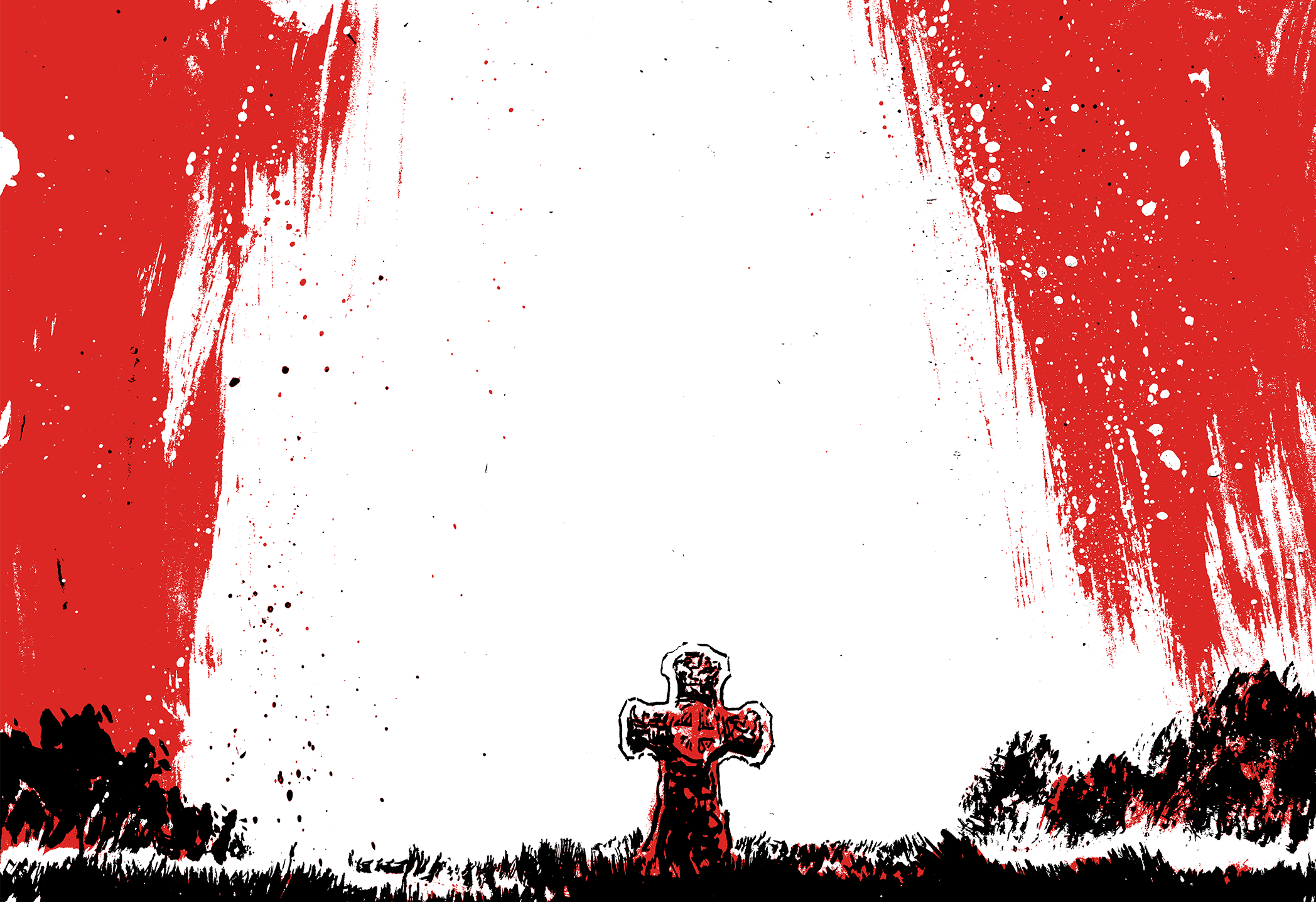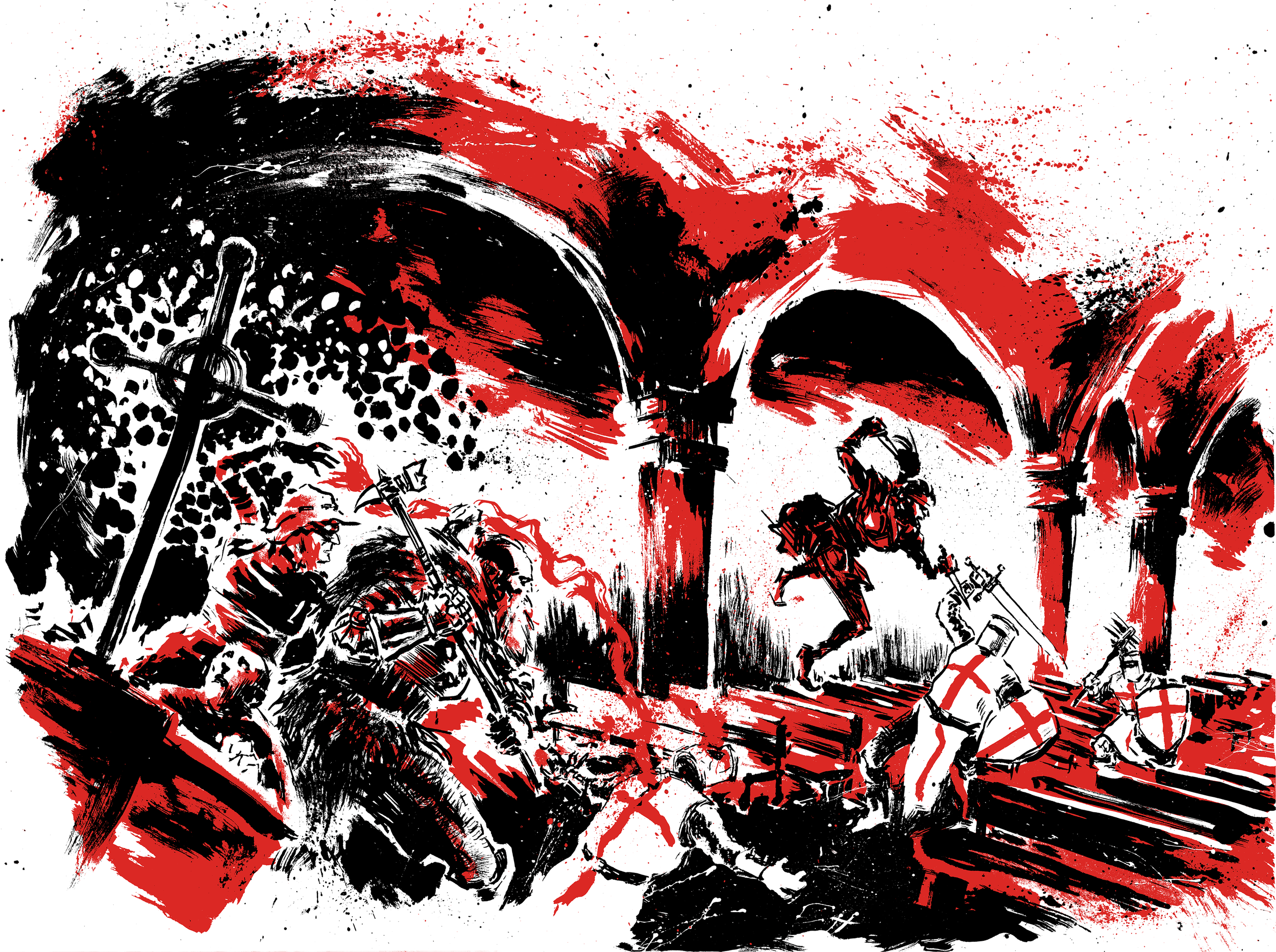
Nominated for three Ennie Awards!
• Best Production Values
• Best Setting
• Product of the Year
A blood-drenched occult medieval roleplaying game in the OSR tradition.
Get the physical books from Exalted Funeral:
Purchase the deluxe slipcase set
Get the PDFs from DriveThruRPG:
Player’s Guide · Referee’s Compendium · The Mythic North
Join our community:
Official Discord
Over $90,000 raised on Kickstarter!
What is Outcast Silver Raiders?
Outcast Silver Raiders is a blood-drenched occult medieval roleplaying game in the OSR tradition.
Outcast Silver Raiders is a work of singular vision from the creative team of:
Professional designer Isaac VanDuyn
Acclaimed heavy metal illustrator Kim Diaz Holm
Fantasy cartographer and calligrapher Lex Rocket
Kim created all the illustrations. Lex created all the maps and hand-wrote all of the page titles in classic blackletter calligraphy. Isaac did all the writing and graphic design. This small team has created a work of dark focus.
Outcast Silver Raiders is what the televangelists, the hack investigative journalists, and the grasping Hollywood producers imagined when they caused a satanic panic around RPGs in the eighties. Daemons. Darkness. Sacrifice. Blood spilling over cracked altars in desecrated chapels. Players portray brutal warriors, clever rogues, and conniving sorcerers who reject the barbaric theocracy of medieval society to seek fortune and glory as outcasts beyond the reach of lords or God.
Outcast Silver Raiders is a distillation of the OSR in service of an occult medieval vision. The rules work within a familiar universal framework established by the world’s most popular roleplaying game and are compatible with thousands of published supplements. Play is fast and simple, focused on player ingenuity and exploration.
People who have never played a tabletop RPG pick up the rules quickly, and experienced gamers appreciate their elegance. If you love the OSR or 5E, you will love this game. If you don't know what the OSR is, this is a great place to start.
Outcast Silver Raiders is a luxury game set which includes everything a group needs to play. The set includes a Player's Guide, a Referee's Compendium, a mammoth-sized campaign book called The Mythic North, and a poster sized map of the Mythic North. All the books are 6" x 9" hardcover volumes printed in color with a ribbon bookmark.
Occult Medieval Hexcrawl
The Mythic North is a full-sized setting book with over 50 hand drawn maps, six competing and interwoven factions, 10 towns full of quests and secrets, and 88 unique encounters (mostly characters, not monsters). By rolling a few dice, referees can combine the places and encounters to create thousands of hours of emergent gameplay without ever sacrificing player agency.
Occult means that magic in the world is secret, dangerous, and somewhat unknowable. This is not a fantasy setting where magic is commonplace. This world mirrors our own, where magic is forbidden and strange. Potions are rarer than crow's teeth. Wizards are terrible beings of legend. Monsters are unique and frightening.
Medieval means that the world is a fictional mirror of medieval society. The church reigns supreme and infests all aspects of life. The gentry stand above the lower classes as super human, assured of their rightful dominance by a judgmental god. Medicine means leeches and bleeding. Education is for the rich. Might makes right. The restrictions of this era breed conflict, and conflict creates great stories.
Roleplaying magic made dangerous
Outcast Silver Raiders contains twenty individually illustrated dæmonic rituals. These rituals were inspired by contemporary and historical magical ceremonies, distilling elements of Goetian, Wiccan, and hermetic magical traditions. They require the collection of strange and rare reagents and following detailed physical steps. The rituals are usable in play by any character class. They are steeped in blood and mystery, and add an occult flavor to any roleplaying game.
·The Books·
There are three books in the set. They will be case-bound, Smyth-sewn hardcovers with an anti-scratch matte finish and 85-pound text-weight interior pages. With stretch goals (see below) we hope to unlock premium features like ribbon bookmarks and gilded edges.
Player’s Guide
64 pages.
The player’s guide includes the rules of the game and rules for the three core character classes:
Rogue, Sorcerer, and Warrior.
Each of these three classes is unique, and has an important role in the party with little overlap in skill sets. Additional classes are included in the Referee's Compendium, but playing with these three core classes is the most authentic occult medieval experience.
Warriors are the best at fighting by a wide margin. Great effort was made to ensure that for warrior players, combat is fun, strategic, and exciting. Warriors guard the party and shed the blood of their enemies. They are tough and dangerous.
Warriors
Rogues are the best at using skills and infiltration. They are the problem solvers of the party, accomplishing feats of cleverness the other party members couldn't dream of. And if they get the chance, they stab people in the back.
Rogues
Sorcerers use dæmonic blood magic, feeding their own blood and health to dæmons to support the party. Dæmons can offer boons of healing, bonuses to rolls, and direct damage to foes.
Sorcerers
The rules system is a distillation of various old school sources:
Characters have the six traditional ability scores, rolled in order.
There are ten skills covering most adventuring situations.
Attack rolls are made with d20s (add modifiers and match target's AC to hit).
Saving throws are made with d10s (add modifiers and succeed on 10+).
Ability and skill checks are made with d6s (add modifiers and succeed on 6+).
Rolling higher is always better.
In playtesting, using unique dice for each situation but always wanting them to roll high made the game easy to pick up for first time roleplayers.
The book is laid out for maximum readability and easy reference at the table. Each spread was considered as one layout, and great effort was made not to split information across spreads.
Referee’s Compendium
144 pages.
A four-section tome meant for referees. Referees describe the characters and places encountered in the game world, and adjudicate the rules fairly and consistently.
The first section of the compendium is advice on how to run Outcast Silver Raiders, or more broadly, any OSR-style game. This will help even beginner referees run fun, effective games at the table, without needing to be a professional actor.
The second section includes 20 individually illustrated rituals, inspired by real world magical practices. Rituals take a long time to cast, require strange and obscure ingredients, and have world-changing effects. There is also a full list of 100 ritual mishaps for when trafficking with dæmons inevitably goes awry...
The third section includes rules for creating powerful but dangerous magical artifacts, advice for including artifacts in a campaign, and sample artifacts.
The last section includes optional rules for classic fantasy races (dwarves, elves, gnomes, half-elves, halflings, half-orcs), and seven extra character classes (barbarian, druid, monk, paladin, priest, ranger, and warlock) along with rules and spells for divine and dæmonic magic. This section is included for easy conversion from other traditional fantasy roleplaying games, but also includes advice on using these extra character options in an Outcast Silver Raiders campaign.
The Mythic North
320 pages.
The Mythic North is a hex-crawl campaign setting for Outcast Silver Raiders (or any OSR style game), set in a low-magic alternate Earth circa 1200 CE. The location is inspired by Scotland, but can be placed easily inside any world.
There are no fantasy races in The Mythic North. There are no thieves or wizards guilds. Monsters exist as legends inhabiting the distant regions of the world. The ascendant church roots out any hint of magic. A low magic setting ensures that when the players do encounter something magical (like an alchemist, a man of brass, undead Roman soldiers, the Spider Kings, or a religiously insane serial killer), it feels truly strange, powerful, and oftentimes horrific.
The Mythic North includes six factions the outcasts can support or vie against, a huge list of 88 encounters focused on storytelling over combat, and 30 keyed, mapped locations (many of which include maps of multiple floors).
Amongst those thirty locations are two large towns, several small towns, a variety of strange and unique locales, 4 multi-level dungeons, and 1 mega dungeon with 12 separate mapped areas. The locations are described using short but descriptive bullets, and illustrated in Lex Rocket’s inimitable style that makes them easily understood and easy to run at the table.
The factions, encounters, and locations neatly tie the world together, making every exploration of the Mythic North feel unique but deeply interconnected. Every piece of the campaign setting is aimed at getting referees up and running quickly, requiring very little preparation between sessions. The map provides tons of space for referees who want to insert their own or other published adventures.
Banding Prison is one of thirty mapped locations (and includes four sub-maps). It is situated on an island off the western coast of the northern marches. It was previously a monastery, and is now a brutal prison where Lord William Dynaver of Cleardor stashes his political opponents. Pictured is a map of the ground floor of the prison’s fortified keep.
The Warlock Towers is another one of the thirty mapped locations in The Mythic North. It is the home of Red Peter, the infamous warlock. Pictured are two of the ten sub maps that make up this mysterious location, showing the ground floors of Edwin Morch’s old square tower, and Red Peter’s new, sumptuous marble tower.

















